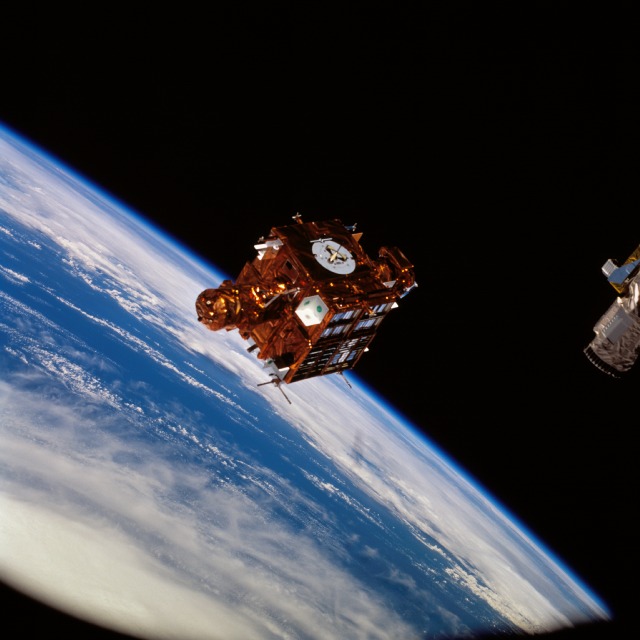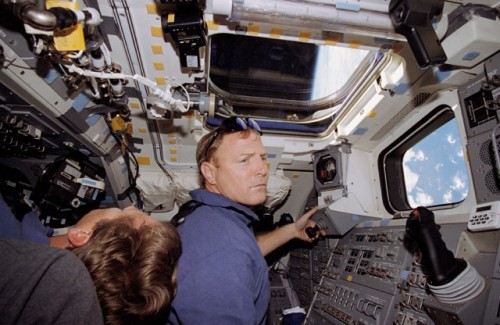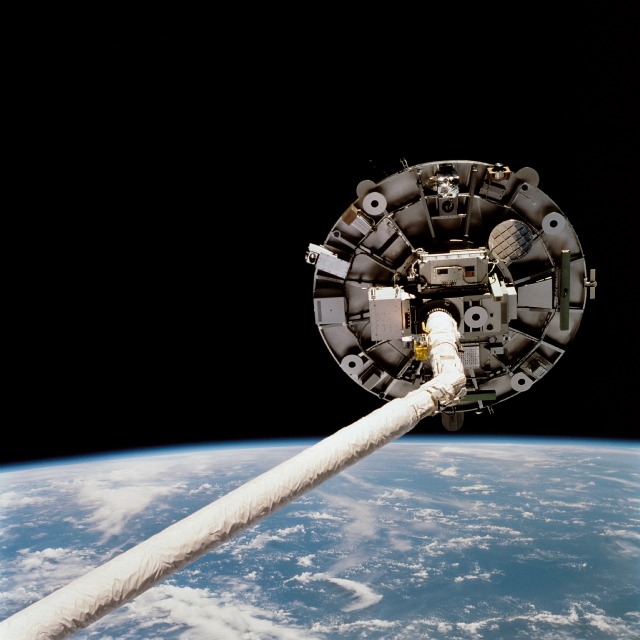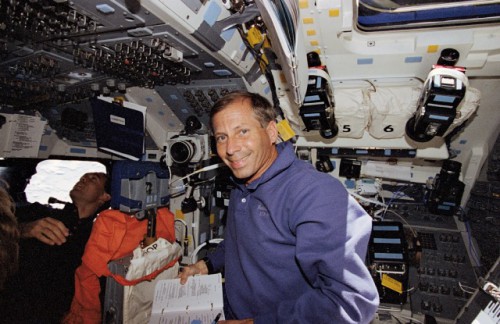
Nineteen years ago, last week, the “Dogs of War” barked, woofed, and yelped their way through a remarkable mission which put virtually all of the space shuttle’s capabilities—satellite deployment and retrieval, rendezvous and proximity operations, spacewalking, and science—to the test. During STS-69 in September 1995, Commander Dave Walker, Pilot Ken Cockrell, Payload Commander Jim Voss, and Mission Specialists Jim Newman and Mike Gernhardt put a series of lengthy delays behind them and successfully completed one of the most impressive and multi-faceted flights in the shuttle program’s 30-year history. One of its most visible goals, as described in yesterday’s AmericaSpace history article, was a complex EVA by Voss and Gernhardt, but STS-69 also made history by becoming the first shuttle mission to deploy and retrieve two satellite during the same flight.
In fact, by the time of the spacewalk, the mission’s two primary payloads had already been successfully deployed and recovered. The first satellite—the Shuttle-Pointed Autonomous Research Tool for Astronomy (SPARTAN)-201—was a 2,200-pound (1,000-kg), cube-shaped spacecraft, designed to accommodate instrumentation for astrophysics or solar physics research. Once deployed from the shuttle, it undertook a pre-programmed mission and was retrieved by the shuttle after two days and returned to Earth for the recovery of data and refurbishment in readiness for its next flight.
STS-69’s first night in space was a disturbed one for Dave Walker, who was awakened twice by a pair of alarms, which indicated a problem in the data path between Endeavour’s General Purpose Computers (GPCs) and the Ku-band communications system. Walker reset the system, and Newman later rebooted it. Next morning, 8 September, the deployment of SPARTAN-201 got underway when Gernhardt released it at 11:42 am EDT. Within minutes of departing the Canadian-built Remote Manipulator System (RMS) mechanical arm, the satellite executed a planned 45-degree pirouette to verify that its internal attitude control system was functioning correctly. Walker and Cockrell then performed two separation burns to maneuver Endeavour away from the payload, creating a mean distance of about 40 miles (64 km) and leaving SPARTAN-201 alone for two days of dedicated solar science operations.

With the retrieval planned for early on 10 September, Walker and Cockrell performed a thruster firing on the 9th to refine Endeavour’s rate of closure and prepare for the rendezvous. By the morning of the 10th, they had maneuvered the shuttle to a distance of just 330 feet (100 meters) from the payload. Gernhardt was scheduled to capture SPARTAN-201 at 10:24 a.m. EDT, but this opportunity was missed due to the payload entering an unexpected attitude during proximity operations. “Concern about whether the SPARTAN had operated correctly was raised when the spacecraft was to be retrieved,” noted NASA in a 29 September news release. “At that time, the crew reported that SPARTAN was rotating slowly and its batteries seemed to have been drained.” Preliminary indications suggested that the payload placed itself into a “safe mode” and shut down its power systems, which prevented it from achieving its intended rendezvous attitude. Consequently, Walker and Cockrell manually flew a 180-degree maneuver “around” their quarry to line up the RMS grapple fixture with the end effector and Gernhardt successfully captured SPARTAN-201 at 11:02 a.m. Approximately 19 minutes later, he had lowered the satellite onto its berth in the payload bay.
At the close of its third mission, SPARTAN-201 was hailed as a huge success by NASA. In late September, after STS-69 had landed, Project Scientist Dick Fisher of the Goddard Space Flight Center in Greenbelt, Md., reported that its data tapes indicated that the payload operated as planned throughout its flight. The attitude issue during the final rendezvous and proximity operations could not be properly investigated until the payload was back on Earth. Nor could a full assessment of its scientific data be made until it was back in the hands of principal investigators. One of the key mission objectives had been to observe the Sun’s north pole, since the mission coincided with the passage of the Ulysses spacecraft over this region. As Ulysses performed in-situ measurements of the physical properties of electrons, protons, and ions in the solar wind, SPARTAN-201 complemented it by completing observations from low-Earth orbit. Specifically, researchers were interested in making collaborative observations of the source of the solar wind and developing a clearer understanding of physical circumstances of the Sun’s outer corona.
With the SPARTAN-201 operations thus behind them, the STS-69 crew focused attention on the second satellite, the Wake Shield Facility (WSF-2), whose RMS-assisted deployment and retrieval was to be undertaken by Newman. The payload was developed by the University of Houston, in conjunction with Dr. Alex Ignatiev, head of the Space Vacuum Epitaxy Center (SVEC). Today known as the Texas Center for Superconductivity at the University of Houston (TcSUH), this institution has for more than two decades explored thin-film deposition, processing and characterization of semiconducting, high-temperature superconducting, and ferroelectric oxide material systems.

As long ago as the 1970s, NASA engineers published papers arguing that a satellite sailing through space would leave an “ultra-vacuum” in its wake, but the absence of practical applications at the time meant that the idea was left unexplored until Ignatiev and his team revived it. In 1986, they joined forces with nine other companies to form a Center for the Commercial Development of Space, with the plan to build a free-flying Wake Shield Facility. It was conceived as an 11.8-foot (3.6-meter) stainless steel disk for the purposes of generating an “ultra-vacuum” within which to grow thin films for future advanced electronics applications. The purely functional shape of the WSF made it appear like a factory cast-off: of dull, silver-grey color, it was a clumsy arrangement of boxes, rods, tubing, and angular shapes. First flown on STS-60 in February 1994, technical difficulties prevented its deployment, and it was “hung” at the end of the RMS to validate its basic concept by growing five thin semiconducting films and gathering associated data. In the aftermath of STS-60, an advisory committee analyzed the anomalies and a NASA independent review board evaluated the satellite’s systems and unanimously agreed that WSF-2 was ready to fly.
Mission plans called for it to grappled by the RMS, under Newman’s control, on 10 September. He would leave it in that position, still latched to its carrier platform, overnight, ahead of the scheduled unberthing and deployment on the 11th. In readiness for WSF-2 operations, Walker and Cockrell had executed a pair of engine firings to slightly raise the shuttle’s orbit. Already, Gernhardt and Newman had begun to slightly shift their sleep schedules, to ensure that one or both of them was awake during all critical mission events. Newman successfully unberthed the payload and maneuvered it into its so-called “ram-cleaning” position for three hours, which was essential for the atomic oxygen of low-Earth orbit to “scour” its ram side and atomically clean it in readiness for two days of semiconductor processing.

The actual deployment was postponed by almost two hours, as flight controllers wrestled with communications dropouts between WSF-2 and the data relay and telemetry equipment aboard its carrier platform in the payload bay. Eventually, Newman released the satellite over the starboard side of the bay at 7:25 a.m. EDT, as Endeavour flew high above West Africa, and WSF-2 executed a perfect firing of its own cold-gas thruster to maneuver away from the orbiter and avoid contamination by waste water dumps, fuel cell purges, and thruster firings. This was the first occasion that a payload had maneuvered itself away from the shuttle; previously, the orbiter had taken the “active” role in such operations.
Nine hours later, at 4:30 p.m., WSF-2 began its first thin-film semiconductor processing run. Described by investigators as a “dirty” run, it lasted about three hours and served to remove any residual contaminants from the containers housing the GaAs sample growth materials. Earlier in the afternoon, Walker and Cockrell had fired the shuttle’s thrusters toward the satellite to slow their relative separation rate, with the intention that by the time of rendezvous and retrieval on 13 September the two spacecraft would be about 30 miles (45 km) apart. By the morning of its second day of operations, WSF-2 had grown three thin films, with seven anticipated before the end of the mission. However, just before the fourth film run commenced, the satellite pitched forward slightly, after sensing a temperature increase, and placed itself into safe mode as a precautionary measure. Operations resumed about 12 hours later, and it was decided to incorporate cooling periods into the WSF-2 timeline and extend the satellite’s phase of free flight by an additional 24 hours. This produced a revised retrieval time of late on the morning of 14 September.
Another delay cropped up when controllers were rendered unable to trigger the flow of arsenic from aluminum source cells on WSF-2 onto a substrate platform. The science instruments were again shut down in the hope that allowing them to cool would permit additional attempts to grow further thin-film samples. It later became clear that the shutter on the source cell had failed to close on command, but investigators doubted that it would negatively affect the quality of the sample. In total, four of the seven planned thin films were satisfactorily grown, with plans for a fifth eventually called off when WSF-2 payload controllers noticed a low reading in one of the satellite’s four batteries.
By the morning of the 14th, Endeavour had closed to within 425 feet (130 meters) of WSF-2, whereupon Walker and Cockrell performed a series of 14 thruster firings to assess the impact of thruster plumes on the satellite’s structure. Newman successfully grappled WSF-2 with the RMS arm at 9:59 a.m. EDT and berthed it back onto its carrier platform in the payload bay at 11:18 a.m. Endeavour’s orbit was subsequently adjusted, ahead of Voss and Gernhardt’s EVA, and STS-69’s final research experiments consumed the closing days of the mission.
Even as their mission entered its final days, the “Dog Crew” of STS-69 could not escape the daily reminders of their canine camaraderie, with “He’s A Tramp,” from the cartoon movie “Lady and the Tramp,” providing their wake-up music one morning. With weather conditions considered near-perfect at the Shuttle Landing Facility (SLF) at the Kennedy Space Center (KSC), and only scattered clouds, light north-easterly winds, and a slight chance of ground fog, Dave Walker was given the green light for the irreversible de-orbit burn at 6:35 a.m. EDT. A little over an hour later, precisely on time, Endeavour alighted on Runway 33 at 7:38 a.m., concluding a mission of slightly less than 11 full days in orbit. Short of actually docking with a “real” space station—which four of the five STS-69 crewmen would accomplish later in their careers—the mission had trialed many of the shuttle’s capabilities and cleared a significant hurdle before the beginning of the ISS era.
This is part of a series of history articles, which will appear each weekend, barring any major news stories. Next week’s article will focus on the 20th anniversary of STS-68, a radar science mission from September 1994, which fell victim to a launch pad abort and serendipitously observed an erupting volcano.
Want to keep up-to-date with all things space? Be sure to “Like” AmericaSpace on Facebook and follow us on Twitter: @AmericaSpace



